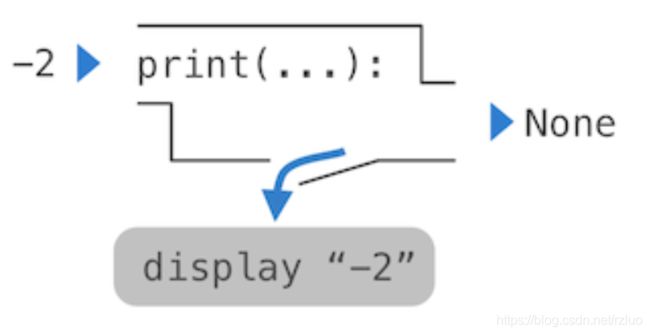CS 61A Spring 2018 Week 1 学习笔记
一、Learning form Textbook
1. 纯函数与非纯函数
Pure functions : 函数有输入(their arguments) and 输出(the result of applying them),比如一些内置函数(built in function)
ex_1
>>> abs(-2)
2
可以描述成如下图

Pure functions have the property that applying them has no effects beyond returning a value.
纯函数的特征是不会产生返回一个值之外的效果。
Non-pure functions:除了返回一个值,非纯函数可能产生副作用(side effect)。常见的side effect 是生成除了返回值外的输出,比如print function
ex_2
>>> print(1,2,3)
1 2 3
尽管在这个例子看来 print() 和 abs() 并无不同,但是他们以完全不同的方式work。print() 的返回值是 None,但是交互式的python interpreter 并不会自动地打印 None 这个值。
而在这个关于print()的case中,显示在屏幕上的output ‘1,2,3’ 是print()被调用的side effect。
ex_3
>>> print(2)
2
>>> print(print(2))
2
None
ex_4
>>> two=print(2)
2
>>> print(two)
None
二、Learning form Homework
1.除号’/'和‘//’的区别
在python中,一个反斜杠 ‘ / ’会输出完整运算结果,即会输出小数点后的,返回的是浮点类型结果。
>>> a=5
>>> b=2
>>> a/b
2.5
而双反斜杠“ // ” 会输出整数结果,即返回整型结果。
>>> a=5
>>> b=2
>>> a//b
2
2. 倒序和排序
(1)字符串颠倒
>>> 'draw'[::-1]
'ward'
(2)对一串数进行排序
>>> sorted([3,5,2,9])
[2, 3, 5, 9] # 默认为升序
>>> sorted([3,5,2,9],reverse=False)
[2, 3, 5, 9] #reverse=False时降序排列
也可以使用 list 的 list.sort() 方法进行排序
3.如何使用homework 中的 doctest 判断代码是否正确
# hw1 Q3
Write a function that takes an integer n that is greater than 1 and returns the largest integer that is smaller than n and evenly divides n.
def largest_factor(n):
"""Return the largest factor of n that is smaller than n.
>>> largest_factor(15) # factors are 1, 3, 5
5
>>> largest_factor(80) # factors are 1, 2, 4, 5, 8, 10, 16, 20, 40
40
>>> largest_factor(13) # factor is 1 since 13 is prime
1
"""
"*** YOUR CODE HERE ***"
我的解答
return max(i for i in range(1, n + 1) if n % i == 0 and i < n)
以 >>> 开头的行称为doctests,它是一个文档测试模块,引入该模块能对我们的程序进行测试。添加以下程序段即可在run窗口中显示测试的相关信息。
if __name__ == "__main__": #模块运行进行自我测试
import doctest
doctest.testmod(verbose=True)
语句 ‘verbose=True’ 强制将详细信息显示出来,故在run窗口中会显示如下信息
Trying:
largest_factor(15) # factors are 1, 3, 5
Expecting:
5
ok
Trying:
largest_factor(80) # factors are 1, 2, 4, 5, 8, 10, 16, 20, 40
Expecting:
40
ok
Trying:
largest_factor(13) # factor is 1 since 13 is prime
Expecting:
1
ok
1 items had no tests:
__main__
1 items passed all tests:
3 tests in __main__.largest_factor
3 tests in 2 items.
3 passed and 0 failed.
Test passed.
4. Hw1_Q4: If Function vs Statement 总结
def if_function(condition, true_result, false_result):
"""Return true_result if condition is a true value, and
false_result otherwise.
>>> if_function(True, 2, 3)
2
>>> if_function(False, 2, 3)
3
>>> if_function(3==2, 3+2, 3-2)
1
>>> if_function(3>2, 3+2, 3-2)
5
"""
if condition:
return true_result
else:
return false_result
def with_if_statement():
"""
>>> with_if_statement()
1
"""
if c():
return t()
else:
return f()
def with_if_function():
return if_function(c(), t(), f())
def c():
"*** YOUR CODE HERE ***"
def t():
"*** YOUR CODE HERE ***"
def f():
"*** YOUR CODE HERE ***"
我的解答:
def c():
return True
def t():
return 1
def f():
print('wfsad')
return None
Note
这道题可以考虑到之前提到的Non-pure 函数 print()会产生side-effect。
并且在执行 return if_function(c(), t(), f())时,解释器会先计算c(),t(),f()。也就是说,即使 c()的return 结果为 True,也不会影响 function f() 的被调用。
参考答案: https://cs61a.org/hw/sol-hw01/
课程网址: http://inst.eecs.berkeley.edu/~cs61a/sp18/
参考文献及网站
[1] Python中关于doctest的使用
[2]CS 61A Spring 2019 HW01 学习笔记
[3]CS61A 教材
